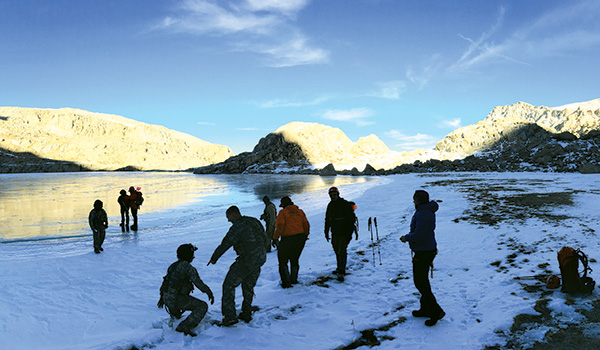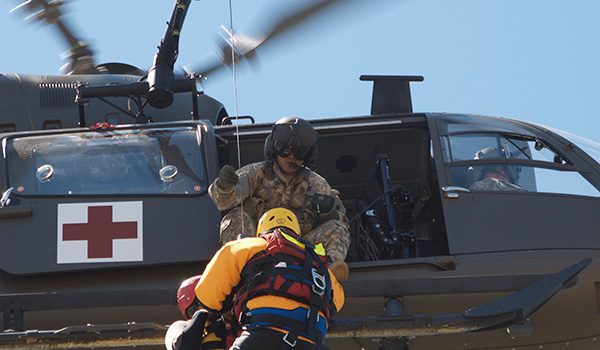
Army National Guard (ARNG) Aviation / By COL J. Ray Davis and COL (Ret.) Kevin Scherrer: During this annual update from your Army National Guard, I’d like to tell you not only where we are, but where we came from, and where we’re heading. Like our Active Component counterparts, our Guard Aviation Force was born not too long ago, and evolved from a lightweight, fixed-wing, tangential capability, into a rotary- and fixed-wing, manned- and unmanned, central and key player on the modern battlefield. And we’re both headed in the same direction: networked, lethal, agile, survivable, and capable of adeptly supporting the ground commander. To do this, I’m going to refer to information from Dr. Michael R. Doubler’s superb Winged Warriors: The History of Army National Guard Aviation, 1948-2008.

CA ARNG Chinook crews from B/1-126th Avn. shutdown at 11,500’ near a frozen lake while waiting for Inyo County search and rescue teams to recover a lost hiker near Mount Whitney on Nov. 21, 2015. CA ARNG routinely partners with Inyo county for seasonal SAR operations when conditions are too extreme for other aviation assets./ PHOTO BY CW4 JOSEPH ROSAMOND, HHC 3/140TH AVN.
The 40’s – Birth of the Force
ARNG Aviation was born in 1948, when it fielded 376 L-16 two-seat airplanes, and another 47 L-17 four-seaters. Against this, 857 pilots were initially authorized. Although this fledgling force was housed in corrugated tin hangars on top of earthen floors, it planted the seeds for the future Guard Aviation Force. These consummate professionals were both tactically and technically competent, thanks largely to extensive World War II experience.
The 50’s – Integrating Helicopters
Although no Guard Aviation units deployed during the Korean War, individual Guard Aviators were recalled to active duty for combat service, where they performed admirably. In 1953, the ARNG received its first helicopters, in the form of the OH-13 Sioux. And while designed as an observation helicopter, the Sioux rapidly expanded its mission set to support the States in their disaster relief efforts. Soon, OH-23 Ravens were added to the Guard fleet, and by 1960, the Guard’s inventory numbered 184 helicopters.
The 60’s – Supporting Efforts in Southeast Asia
By 1960, the Guard’s fixed-wing inventory had grown to 659 airplanes, mostly L-19 Bird Dogs. This number declined in the 1960s, as the Active Component recalled about 100 aircraft for service in Vietnam. In 1966, the ARNG received its first true utility helicopter, the piston-powered H-19 Chickasaw. As with Korea, no ARNG units were mobilized for service in Vietnam, but about 200 ARNG aviators volunteered for combat service, and many distinguished themselves. Of particular note is Aviation Hall of Fame member LTC Jerome Daly, who earned a DSC, two Silver Stars, three DFCs, and two Purple Hearts during service overseas. As DUSTOFF aircraft became familiar sights in Vietnam, the ARNG began perfecting MEDEVAC procedures back at home. In 1969, The Nebraska ARNG used its fleet of H-19s to experiment with rescue missions along the nation’s highways. Integrating closely with police and medical agencies, the ARNG established the CONUS air rescue system used widely by civilian operators today.

A California Army National Guard LUH-72 Lakota flown by pilots CW4 Michael Rathe and CW2 Kevin Vinatieri, hovers over Lake Oroville while crew chief, SGT Sy, hoists two members of a search and rescue team to safety. The aviators, assigned to the Stockton-based 3-140th Avn. were supporting local and regional search and rescue teams at the annual Swiftwater event, April 15, 2015, which trains first responders in saving people from various water resources and conditions./CA ARNG PHOTO BY MSG PAUL WADE, PUBLIC AFFAIRS OFFICE
The 70’s – Vast Expansion of the Inventory
In 1971, the ARNG fielded its first OV-1 Mohawk, but as the decade wore on, its total fixed-wing fleet decreased to about 128 aircraft. Helicopters were another matter. By 1970, the Guard’s helicopter fleet was up to 605 aircraft, and in October of that year, its expansion accelerated with the introduction of the venerable UH-1 Iroquois – aka, the Huey. By the end of the decade, the Guard helicopter fleet stood at 2416 aircraft, mostly Hueys (this is almost double what the ARNG has on hand today!). NOE, instrument flight, and a renewed focus on potential combat in Europe were hallmarks of the 70’s, along with a substantial influx of experience and talent that Vietnam veterans brought to the force.
The 80’s – New Aircraft and New Demands at Home
In 1980, the Guard fielded its first AH-1 Cobra, replacing Huey gunships that equipped its attack and cavalry formations. In 1983, the ARNG accepted its first UH-60 Black Hawk and its first C-12 Huron. And in 1986, the AH-64 Apache entered the Guard force. To fly these new machines, the ARNG had to recruit a new generation of pilots, as its Vietnam-era population began to retire. To help Fort Rucker handle its institutional training load, the ARNG stood up the Eastern ARNG Aviation Training Site (EAATS) in 1981 and the Western ARNG Aviation Training Site (WAATS) in 1986. In addition to preparing for combat on the North German Plain, the ARNG increased its focus on a growing counter-drug mission and a rash of major natural disasters. The Mount St. Helens eruption, Hurricane Hugo, and the San Francisco earthquake each put Guard Aviation at center-stage, demonstrating their value to the States’ Governors and citizenry.

A crew from the Wisconsin Army National Guard prepares an RQ-7B Shadow for launch./ WI ARNG COURTESY PHOTO
The 90’s – Funding-challenged After the Cold War
The 90’s opened with Operation Desert Shield/Storm, and Guard Aviation’s role was small, but noteworthy. Fifteen units and 2,431 personnel mobilized and served during the war, either overseas or as backfill for deploying Active Component units. Following the Gulf War, the Army resumed its post-Cold War downsizing, with considerable effect on ARNG Aviation. Although the 1993 “Off-Site Agreement” sustained the ARNG’s combat and combat support missions, the Guard’s aircraft inventory and training budget shrank significantly. This forced a new level of interstate cooperation in response to domestic disasters, and pooling of aviation resources was necessary to respond to Hurricane Andrew and western wildfires. By the end of the decade, ARNG Aviation was a smaller, but more modernized and engaged force, struggling through budgetary challenges to support training and operations at home.
The 00’s – An Operational Force for Southwest Asia
9-11 changed everything. The ARNG went “globally operational,” deploying almost every aviation formation to Iraq or Afghanistan or both, and becoming indistinguishable from their Active Component peers. There are too many examples to list here, but one noteworthy example is 1-149th Aviation, an attack-reconnaissance battalion headquartered in Texas, which deployed to Balad in 2006 and is illustrative of a true ARNG Warfighting unit. They flew over 18,000 hours, supported conventional and unconventional forces across Iraq, and earned a Valorous Unit Award, 12 Distinguished Flying Crosses, and 39 Air Medals for Valor.
Today
So here we are in 2016. As of this writing, the ARNG force stands at 1 theater aviation command, 8 combat aviation brigades, 4 theater aviation brigades, 8 attack-reconnaissance battalions, 15 assault battalions, 13 general support aviation battalions, 6 security and support battalions, 2 fixed wing battalions, 4 ARNG aviation training sites, 4 theater area support maintenance groups (TASMGs), 1 TASMG(-), and 11 aviation support battalions. That equates to (in terms of authorizations) 869 UH-60s, 192 AH-64s, 212 UH-72s, and 161 CH-47s. 29,520 Aviation personnel postured among 54 States, Territories, and the District of Washington. sixteen company-level units, 53 aircraft, and 1,472 personnel are currently mobilized and deployed overseas.
Tomorrow
As the great philosopher Joe Cocker once penned, “Who knows what tomorrow brings.”
The National Commission on the Future of the Army (NFCA) has made pointed recommendations on the Army’s Aviation Force. What Congress and the SecDef will enact is anyone’s guess. What future defense budgets will look like is pure conjecture. But even with all that uncertainty, here’s what my crystal ball shows:
- Guard Aviation will sustain its current mobilization and deployment OPTEMPO, supporting Kosovo, Kuwait, and eventually a third location overseas (Europe? Korea?).
- Within the next 2-3 years, the Guard will respond to a Katrina-sized natural disaster, requiring aviation assets from across the country.
- Some flag re-alignment will occur within the next 5-7 years, enhancing our ability to rapidly generate readiness.
Regardless of specifics, you can be sure of this: the ARNG Aviation Force will be ready, responsive, and able to mobilize and deploy in defense of our Nation, and be ready to respond to the needs of its States’ leadership. A team of professionals, dedicated to the Army mission and steeped in the Army’s values. An aviation force that is truly, “Above the Best.”
Fly Safe, Fly Guard.
COL J. Ray Davis is the chief of the Aviation and Safety Division for the Army National Guard Directorate, in Arlington, VA. COL (Ret.) Kevin Scherrer is a support contractor with Kord Technologies.










